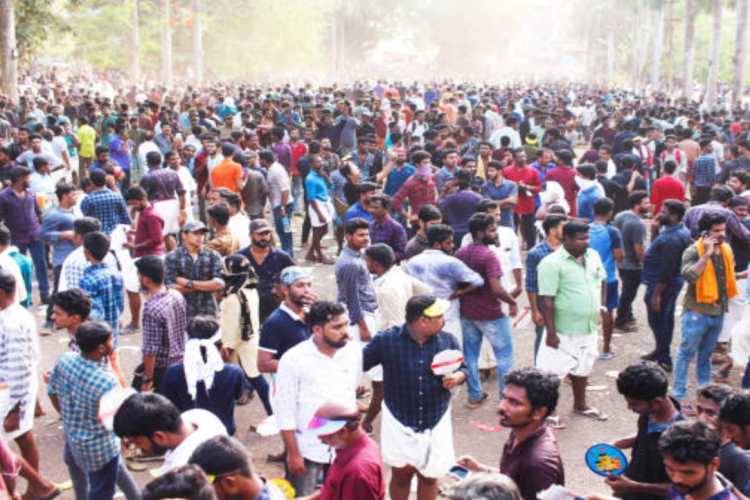
Crowd management failure at Karur: Months after India was shaken by a crowd crush during Royal Challengers Bengaluru’s maiden IPL title celebration, another tragedy has struck, this time in Karur, Tamil Nadu. On September 27, a political rally led by film star–turned–politician Vijay ended in disaster, leaving 41 people, including children, dead. It was Tamil Nadu’s worst political rally mishap in recent memory.
Stampedes in India are no longer rare accidents but a recurring failure of governance and planning. From religious pilgrimages like Sabarimala and Prayagraj to sporting celebrations in Bengaluru and political rallies such as the recent Karur tragedy, mass gatherings routinely slip into chaos when crowd sizes overwhelm the arrangements. Each incident exposes the same gaps — underestimated attendance, weak enforcement of safety norms, inadequate infrastructure, and poor coordination among organisers, police, and local administrations. The repetition of such disasters shows that India has not built a systematic framework for crowd safety, relying instead on blame games and compensation rather than prevention and accountability.
READ | Rising protectionism signals end of free trade era
Crowd management failures
Large gatherings demand meticulous planning and strict enforcement of safety protocols. But when popular figures attempt to transform fan adulation into political capital, safety often becomes expendable. From temples to stadiums, India has seen repeated stampedes because precautions are treated as afterthoughts. The Karur tragedy follows a pattern of negligence that has played out across the country.
The images from Karur were harrowing: families crushed in their attempt to glimpse a celebrity, ambulances struggling to move through panicked crowds, and police unable to contain the surge. Permissions were given for a limited turnout, but actual attendance far exceeded estimates, as it did in Bengaluru. By dusk, bottlenecks turned deadly. Dozens were suffocated before the rally concluded. The state moved quickly with medical aid, compensation, and an inquiry, but the larger question remains—why are such disasters recurring?
Prevention, not blame game
India’s approach to crowd safety remains reactive. Outrage follows each incident, commissions are appointed, but reforms rarely last. Event organisers prioritise turnout and spectacle over basic safety. Venues are chosen for symbolism rather than capacity. Crowd estimates are deliberately understated to secure easier permissions. Enforcement by authorities is lax.
Prevention must be the focus. No rally, festival, or tournament should proceed without a detailed safety blueprint covering crowd movement, entry and exit points, medical facilities, and evacuation plans. Risk assessments should be dynamic—accounting for peak hours, weather, and unplanned surges. Treating permission as a one-time clearance rather than a continuous obligation is a fundamental flaw.
Lessons in crowd psychology
Crowd panic spreads quickly in tightly packed spaces. Police and volunteers require systematic training in directing people calmly, preventing choke points, and keeping corridors open for medical access. In Karur, ambulances were delayed because no pre-planned access routes existed. These failures are preventable if authorities anticipate human behaviour in dense gatherings.
Public figures also bear responsibility. Charismatic leaders must recognise that their popularity carries risks. Smaller, more frequent appearances in safer venues would disperse crowds. Strict penalties for organisers who neglect safety are essential to ensure compliance.
Towards a national framework
The judicial commission announced after Karur should not end as another paper exercise. Its findings must feed into a national framework for public event safety that applies equally to rallies, religious festivals, sports tournaments, and cultural gatherings. India cannot treat deadly stampedes as inevitable collateral of mass mobilisation.
Accountability must extend to all stakeholders—organisers who chase numbers, police who fail to enforce rules, and administrators who underestimate risks. Victims’ families deserve justice beyond token compensation.
Some of the best examples of crowd management come from countries that have institutionalised safety as non-negotiable. The Hajj pilgrimage in Saudi Arabia, which attracts over two million people annually, is now managed through timed entry permits, designated routes, and real-time monitoring systems that have sharply reduced fatalities in recent years.
Japan’s meticulous planning for major festivals and Tokyo’s commuter rush involves precision crowd flow designs, constant public announcements, and highly trained volunteers. At London’s Wembley Stadium or New York’s Times Square on New Year’s Eve, layered security cordons, digital surveillance, and clear evacuation routes are standard practice. These examples show that large gatherings need not be synonymous with danger if planning is rigorous and execution uncompromising.
Awareness and technology
Public awareness is also critical. Temples like Tirupati conduct regular sessions for devotees on safe conduct. Globally, the Hillsborough disaster of 1989 in the UK reshaped safety protocols at sports events. India too must evolve guidelines that are rigorously enforced.
Technology can play a role. AI-powered monitoring, drones, and real-time surveillance can track crowd density and alert authorities to risks. Social media trends often provide early signals of surges in turnout. With foresight, coordination, and vigilance, stampedes can be prevented.
Every mass gathering tests the balance between public enthusiasm and public safety. When that balance tips, the result is tragedy. What India needs is not just swift post-disaster responses but a culture of planning where human safety is the first principle, not the last consideration.
